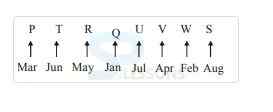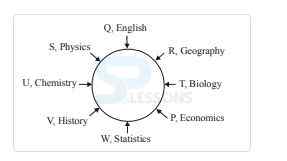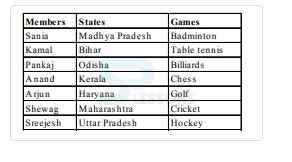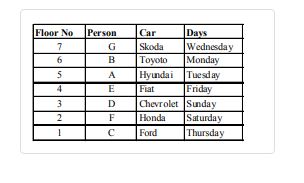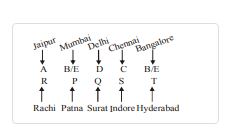 Introduction
Introduction
LIC has announced the LIC Assistant Recruitment 2019 with a total of 7871 Posts. LIC Assistant Preliminary exam is scheduled to be held on 21-10-2019 and 22-10-2019 (tentative). Get the complete details of LIC Assistant Reasoning Ability Syllabus along with exam pattern and samples. Candidates can check the daily updates from LIC Official Website
 Exam Pattern
Exam Pattern
LIC Assistant Reasoning Ability - Prelims Exam Pattern
| LIC Assistant Exam Pattern - Prelims | ||||
|---|---|---|---|---|
| S.No | Name Of Test | No.of Questions | Maximum Marks | Duration |
| 1. | English Language / Hindi Language | 30 | 30 | 20 Minutes |
| 2. | Numerical Ability | 35 | 35 | 20 Minutes |
| 3. | Reasoning Ability | 35 | 35 | 20 Minutes |
| Total | 100 | 100 | 60 Minutes | |
| LIC Assistant Syllabus - Reasoning | |
|---|---|
| S. No. | Name of the Topic |
| 1. | Inequalities |
| 2. | Ordering and Ranking |
| 3. | Directions & Distances |
| 4. | Coding & Decoding |
| 5. | Blood Relations |
| 6. | Syllogisms |
| 7. | Circular and/or Linear Seating Arrangement |
| 8. | Statements and Assumptions |
 Samples
Samples
DIRECTION (1-5): Study the following information carefully to answer the given questions.
Eight people - P, Q, R, S, T, U, V, and W are sitting in a straight line facing North. Each of them went to tour in different months, viz January, February, March, April, May, June, July, and August but not necessarily in the same order. V sits third to the right of the person who went to tour in May. V went to tour after P. The person who went to tour in August sits second to the right of V. R went to tour before July. Neither P nor T went to tour in either May or August. Neither P nor T is an immediate neighbor of V. W sits third to the right of the person who went to tour in January. Neither P nor T went to tour in January. W went to tour in one of the months mentioned above but not in August. Only two people sit between T and the person who went to tour in July. The person who went to tour in February sits on the immediate left of S. Only one person sits between T and Q. T went to tour after April. P and T are immediate neighbors of each other.
1. In which of the following months, W went to tour?
- A. April
B. June
C. July
D. February
E. March
- A. The person who went to tour in May
B. The person who went to tour in January
C. S
D. P
E. The person whose joining date is in August
- A. Only two people sit to the left of T.
B. S is sitting second to the right of the person who went to tour in July
C. T and Q are immediate neighbours of S
D. S went to tour in May
E. None of the Above
- A. None
B. One
C. Two
D. Three
E. Four
- A. P and S
B. The person who went to tour in May and T
C. R and V
D. The persons who went tour in March and June
E. None of these
DIRECTION(6-10): Study the following information carefully to answer the given questions
Eight friends - P, Q, R, S, T, U, V, and W are sitting around a circular table All of them are facing the center. Each of them likes different subjects i.e. Economics, Statistics, English, History, Geography, Biology, Chemistry, and Physics but not necessarily in the same order. S likes Physics. R and T are immediate neighbors of each other. The one who likes Geography sits to the immediate left of Q. The one who likes biology sits second to the right of the one likes Statistics. The one who likes Chemistry is an immediate neighbor of the one who likes History. W is second to the right of U. Q is sitting second to the left of U. NeitherR nor T like History. The one who likes Physics is an immediate neighbor of U. R is second to the right of the one who likes Economics. There are only three people sits between the one who likes Physics and P. Only one person sits between the one who likes History and P. The one who likes Statistics is to the immediate right of the one who likes History.
6. Who among the following likes English?
- A. Q
B. P
C. R
D. S
E. None of these
- A. Five
B. Two
C. Three
D. Four
E. None of these
- A. V is an immediate neighbour of P
B. The immediate neighbor of V are R and T
C. V is third to the right of the person who likes Biology
D. None of the given statements is true
E. V sits opposite to R, who likes Geography
- A. The person who likes Statistics
B. The person who likes Economics
C. The person who likes Physics
D. Can't be determined
E. None of these
- A. S, R
B. R, P
C. Q, R
D. S, V
E. V, P
DIRECTION(11-15): Study the following information carefully to answer the given questions
Seven Members Sania, Kamal, Pankaj, Anand, Arjun, Shewag and Sreejesh represents seven different states Madhya Pradesh, Uttar Pradesh, Bihar, Kerala, Haryana, Odisha and Maharashtra in seven different games Hockey, Chess, Cricket, Badminton, Table Tennis, Golf and Billiards. The order of persons, states and games is not nescessarily in the same order.
- Anand represents Kerala in chess. Arjun represents golf team but not from Maharashtra or Uttar Pradesh.
- Sania represents Madhya Pradesh for either badminton or table tennis. Pankaj represents Odisha but not for cricket or Table tennis.
- The one who represents Bihar represent in Table tennis. The one who represents Hockey represents Uttar Pradesh.
- Shewag represents Cricket and from Neither Bihar nor Uttar Pradesh.Sreejesh does not represent Bihar.
- A. Kamal
B. Anand
C. Sreejesh
D. Sania
E. None of these
- A. Pankaj - Kerala
B. Kamal - Cricket
C. Shewag - Maharashtra
D. Anand - Golf
E. None of these
- A. Arjun
B. Kamal
C. Sreejesh
D. Sania
E. None of these
- A. Sania-Table Tennis-Bihar
B. Anand-Kerala-Billiards
C. Arjun-Haryana-Golf
D. Pankaj-Uttar Pradesh-Hockey
E. Sreejesh-Chess-Madhya Pradesh
- A. Kamal
B. Arjun
C. Pankaj
D. Sreejesh
E. None of these
DIRECTIONS(16-17): Each of the following questions is based on the following information
- Six flats on a floor in two rows facing North and South are allotted to P, Q, R, S, T and U.
- Q gets a North facing flat and is not next to S.
- S and U get diagonally opposite flats.
- R next to U, gets a south facing flat and T gets North facing flat.
- A. P
B. Q
C. R
D. T
E. None of the above
- A. QTS
B. UPT
C. URP
D. Data is inadequate
E. UQS
- P@Q - P is neither greater than nor equal to Q
P%Q - P is neither smaller than nor equal to Q
P#Q - P is not greater than Q
P$Q - P is not smaller than Q
P*Q- P is neither smaller than nor greater than Q
- A. Only conclusion I follows
B. Only conclusion II follows
C. Either conclusion I or II follows
D. Neither conclusion I nor II follow
E. Both conclusion one and two follows
- A. Only conclusion I follows
B. Only conclusion II follows
C. Either conclusion I or II follows
D. Neither conclusion I nor II follow
E. Both conclusion one and two follows
- A. Only conclusion I follows
B. Only conclusion II follows
C. Either conclusion I or II follows
D. Neither conclusion I nor II follow
E. Both conclusion one and two follows
- A. Only conclusion I follows
B. Only conclusion II follows
C. Either conclusion I or II follows
D. Neither conclusion I nor II follow
E. Both conclusion one and two follows
- A. Only conclusion I follows
B. Only conclusion II follows
C. Either conclusion I or II follows
D. Neither conclusion I nor II follow
E. Both conclusion one and two follows
DIRECTION(23-25): Read the following information carefully to answer the following questions
- 'P # Q' means 'P is the daughter of Q'
'P © Q' means 'Q is the brother of P'
'P = Q' means 'Q is the sister of P'
'P & Q' means 'P is the son of Q'
'P * Q' means 'P is the father of Q'
'P @ Q' means 'P is the mother of Q'
- A. V is the husband of P
B. R is the son of V
C. R is the daughter of V
D. V is the wife of P
E. None of these
- A. C & V # N @ L © D
B. C & V & L @ N © D
C. D & L & N @ V © C
D. D & N # V @ L © C
E. None of these
- A. Q is the grandson of M
B. L is the uncle of N
C. N is the uncle of Q
D. Q is the niece of N
E. None of these
- A lives an odd-numbered floor but not on floor numbered Three. Only two persons live between D and the one who owns Toyota. The one who owns Honda lives immediately above C. The one who owns Toyota went to tour on one of the days before Thursday.
- The one who owns Hyundai lives on odd-numbered floors above D. B lives on the floors above E. Only three persons live between C and the one who owns Hyundai. The person who went to tour on Friday owns Fiat Car.
- The one who owns Fiat lives immediately above the one owns Chevrolet. G lives on an odd-numbered floor. E does not own Honda. D went to tour on Sunday.
- Only one person lives between B and E. The one who owns Toyota lives immediately above A. Neither C nor A owns Skoda. The one who went to tour on Wednesday immediately after the one who owns Hyundai.
- The one who owns Honda went to tour immediately before the one who lives on floor no 3. There are two persons live the floor no 4 and the person who went to tour Wednesday. The one who went to tour on Wednesday is not C.
- A. Skoda
B. Toyota
C. Fiat
D. Hyundai
E. Ford
- A. Ford - C
B. Hyundai - F
C. Chevrolet - G
D. Fiat - D
E. Ford - B
- A. Four
B. None
C. Two
D. One
E. Three
- A. The one who owns Honda went to tour on the day immediately after E.
B. F likes Fiat
C. None of the given options is true
D. Only four persons live between D and G
E. G lives immediately below E
- A. B
B. The one who owns Fiat
C. The one who owns Hyundai
D. D
E. F
DIRECTION(31-35): Study the following information carefully to answer the given questions.
Ten persons from different cities viz. Delhi, Jaipur, Patna, Indore, Mumbai, Chennai, Hyderabad, Bengaluru, Ranchi and Surat are sitting in two parallel rows containing five people each, in such a way that there is an equal distance between adjacent persons. In row 1- A, B, C, D, and E are seated and all of them are facing south. In row-2 P, Q, R, S, and T are seated and all of them are facing north. Therefore in the given seating arrangement, each
member seated in a row faces another member of the other row. (All the information given above does not necessarily represent the order of seating in the final arrangement.)
- P faces one of the immediate neighbors of the person from Jaipur. P does not face A. The person from Delhi sits second to the right of the person from Bengaluru.
- D faces one of the immediate neighbors of the person from Patna. S is not from Patna. D is not from Mumbai. R sits second to the left of the persons from Surat. A sits third to the right of the person from Chennai.
- Only One person sits between the person from Ranchi and Q. The person from Indore sits to the immediate right of Q. C sits to the immediate left of the person who faces Q. Only two people sit between B and E.
- The person from Mumbai sits second to the right of the one who faces S. S does not sit at an extreme end of the line. One of the immediate neighbors of the person from Mumbai faces Ranchi.
- A. The person from Delhi
B. D
C. The person from Chennai
D. The person from Ranchi
E. B or E
- A. Patna
B. Indore
C. Hyderabad
D. Ranchi
E. Mumbai
- A. C sits an extreme end of the line
B. None of the given options is true
C. C is from Bengaluru
D. The person from Indore faces C
E. The person from Hyderabad is an immediate neighbour of C
- A. Delhi
B. Surat
C. Patna
D. Hyderabad
E. Ranchi
- A. The person from Delhi and R
B. The persons from Bengaluru and A
C. A and the person from Patna
D. The persons from Chennai and Patna
E. A, E




